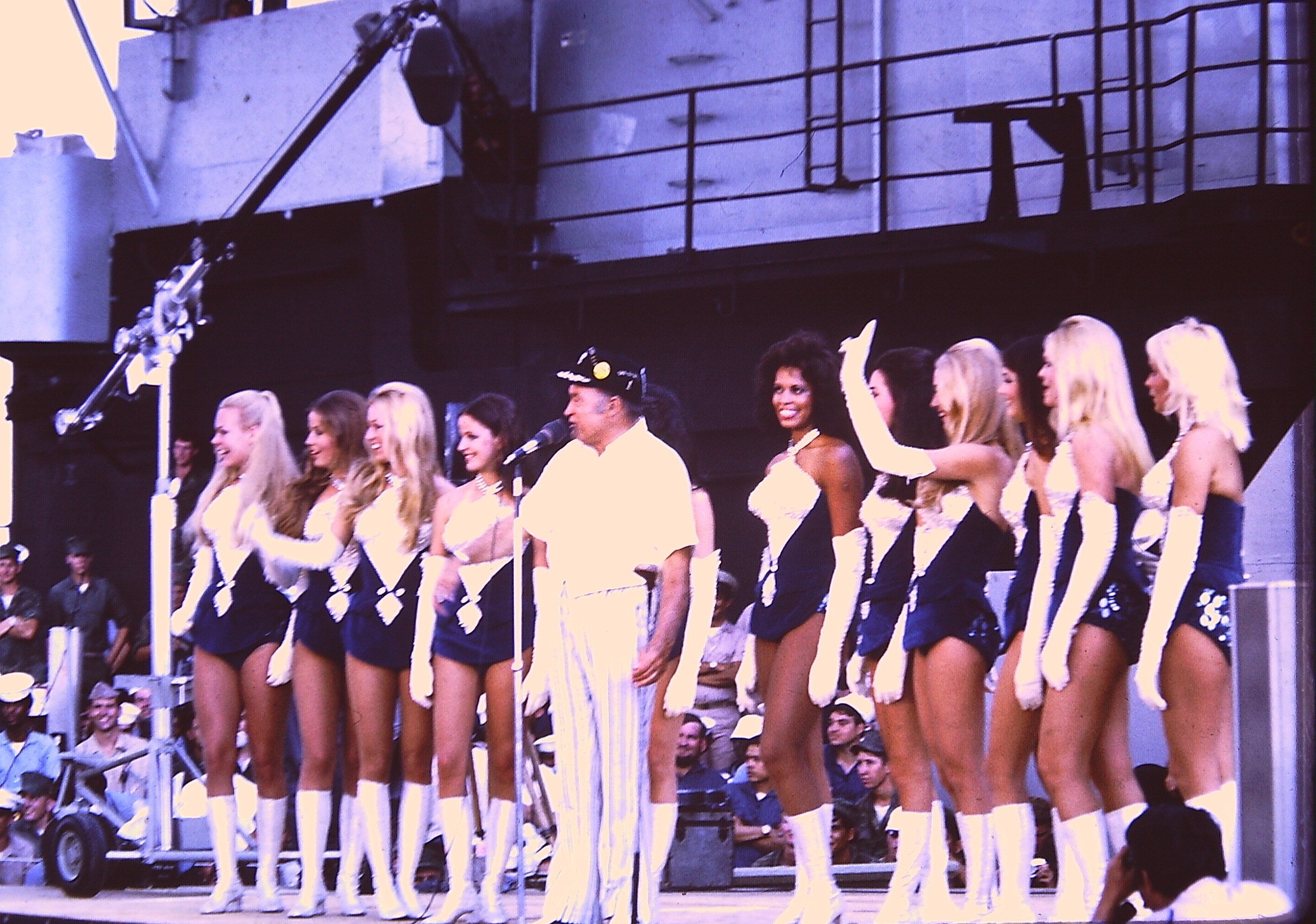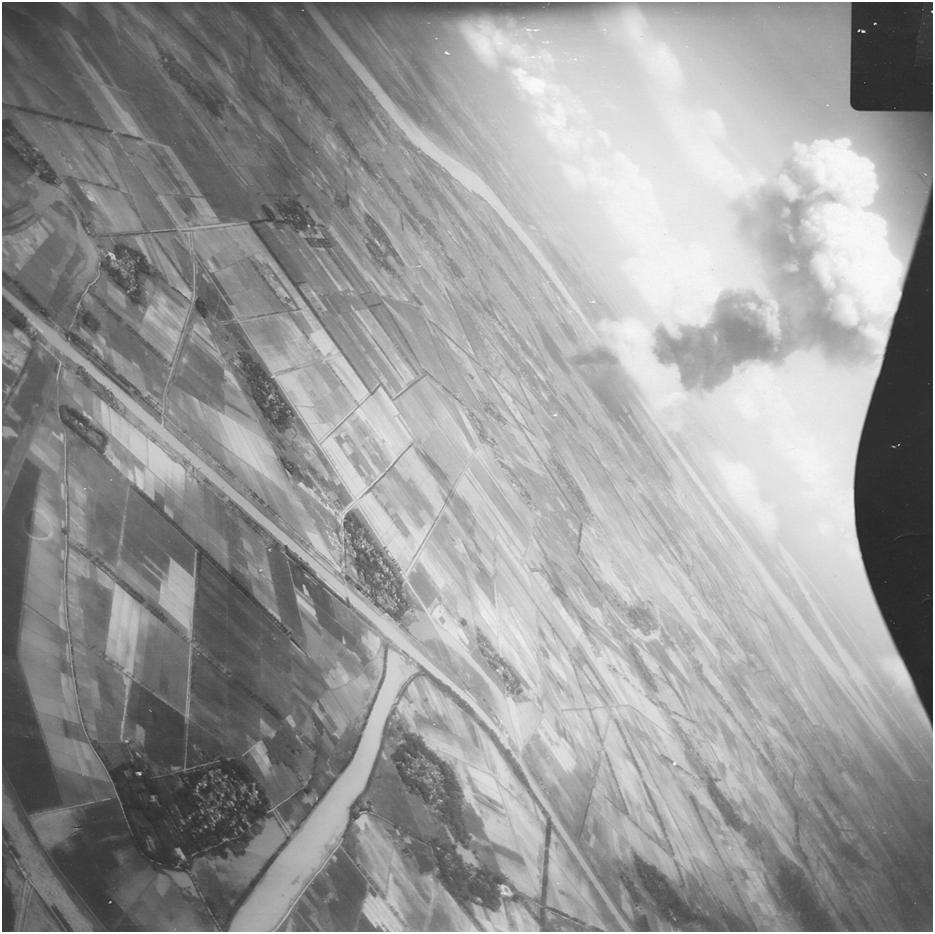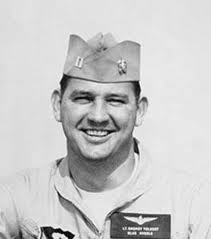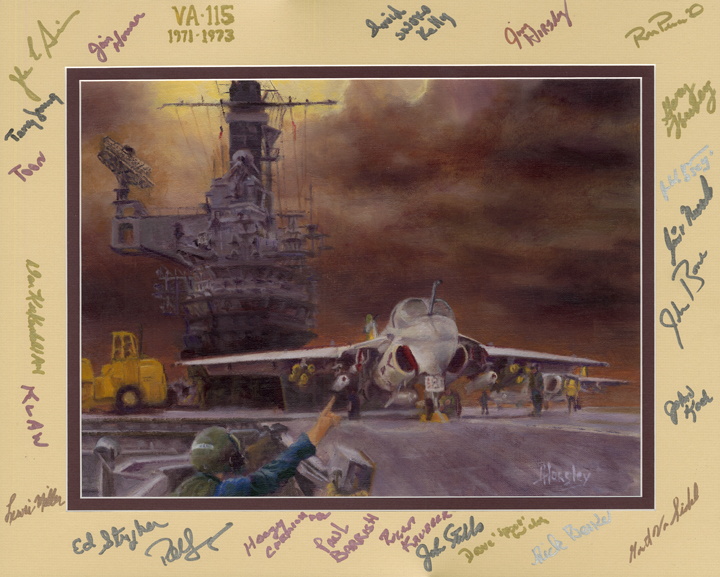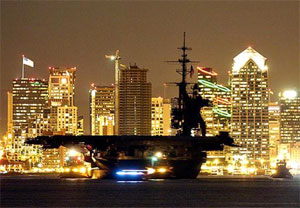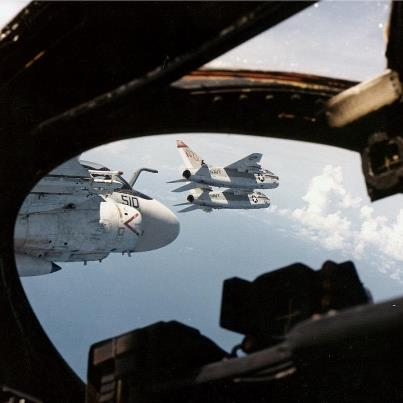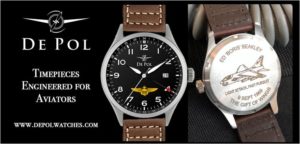My MIG Kill at Kien An Airfield
Continuing excerpts from Not on My Watch, by Dave ‘Snako’ Kelly
Despite the official story, I did ‘kill’ a MIG. (And I have photographic evidence to back it up!) There is, however, some background information that predicates this story.
There has always been strife between the Attack and Fighter communities within Naval Aviation. The fighter pilots have their inflated self-image, as ‘cold-blooded, steely-eyed killers’. They feel their purpose in life is to kill MIGs, and anything that prevents them from fulfilling that destiny is a ‘senseless activity’. Unfortunately in the real world periodically people put heavy, high-drag bombs on their planes and make them fly attack missions. This is probably the last thing they ever want to do, but it comes with the territory.
We used to joke that as soon as those bombs left their planes, the 125 mil ballistics drop (the setting entered into the gunsight of the aircraft to give a visual reference for where a bomb will hit the ground following release at a specific airspeed, altitude, and dive angle.)they had dialed-in for the bombs, would immediately reset to 35 mils, the trajectory drop for a Sidewinder Air-to-Air Missile. (I may be wrong here, rather than “immediately”, they may have waited until they had actually pulled out of the dive before they reset the gunsight.)
The Attack Community has a mission to ‘disrupt the enemy and deny him of his treasures’. We felt that this was somehow a ‘higher purpose’. The enemy wasn’t going to end the war, because we shot down all his MIGs, but if we denied him of his lines of communication, supplies, personnel support, etc. we felt that we could make a difference. We could also harass him by flying around his country at high speed and low altitude all hours of the day or night dropping bombs on his industrial facilities, commerce on his highways, or boats moving up and down his coast and waterways.
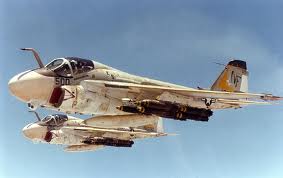 While daytime flights were always escorted by the fighters, at night the A-6s flew single-plane missions into RP VI without any sign of fighter cover. Of course there was the BARCAP, a pair of F-4s hovering 20 to 30 miles off the coast. During each 12-hour period of flight operations, the active carrier in the Gulf had to support the BARCAP mission with a pair of fighters during each launch cycle. Theoretically these guys were positioned to protect the Fleet from attack and to cover aircraft as they went ‘feet wet’. So ultimately, they were actually ‘working for us’.
While daytime flights were always escorted by the fighters, at night the A-6s flew single-plane missions into RP VI without any sign of fighter cover. Of course there was the BARCAP, a pair of F-4s hovering 20 to 30 miles off the coast. During each 12-hour period of flight operations, the active carrier in the Gulf had to support the BARCAP mission with a pair of fighters during each launch cycle. Theoretically these guys were positioned to protect the Fleet from attack and to cover aircraft as they went ‘feet wet’. So ultimately, they were actually ‘working for us’.
The ship, however, just couldn’t always put up two fighters for that mission. By the time they launched and climbed to their perch at 25,000 feet, the two fighters would most likely be at ‘low (fuel) state’, so in addition to the BARCAP, they had to launch a BARCAP tanker (an A-6, A-3, or A-7 aircraft), as a dedicated fuel source for the pair. If an unfortunate MIG was ever to venture off the coast, he would have these two bozos to deal with, and in 1972 the MIGs were not fairing very well in their engagements with Navy aircraft. The ratio was something like 20 to 1 in favor of Navy Fighters.
One of the ‘carrots’ for a fighter who was fortunate enough to nail a MIG was the automatic award of a Silver Star (medal). This was a ‘given’, you shoot down a MIG and receive a Silver Star. There was no such equivalent in the Attack Community. There was no mission or situation that was the equivalent to downing a MIG.
This could be taken to ridiculous extremes. One of the half dozen MIGs shot down by ‘steely-eyes’ aboard MIDWAY during the ’72-73 Cruise was some poor ‘Nuygen’ who was in the landing pattern at one of the airfields along the coast of NVN. One night in rather bad weather one of the ships in the gulf picked up a radar blip of a MIG trying to get into one of the minor airfields near the coast. RED CROWN called up the BARCAP, and they were off and running.
The MIG pilot must have thought he was home-free as he approached the outlying field at night and in bad weather. This was not, however, the case. A pair of our VF-161 fighters locked one of their Sparrow missiles on to this poor guy. While he was dirtied-up (landing gear and flaps down for landing) and from 5 miles away (‘feet wet’), they launched the missile. Of course there was no way to confirm the kill, but when that radar blip disappeared, ‘ching-ching’, another Silver Star was awarded to a Fighter Jock.
This sets the stage for my ‘MIG Kill’ story.
So the mission was a late afternoon Alpha Strike on the two airfields, Kien An and Cat Bi, which are about 10 miles apart and just south of Haiphong. Despite being near the coast, this wasn’t really a ‘walk-in-the-park’ mission. We didn’t expect it to be an anus-clinching event either. We would be flying within sight of one of the major and well-defended cities, but the strike wasn’t going to take us more than about 10 or 15 miles ‘feet-dry’. I think most of us felt that at 500 knots, even if you were hit, you should be able to make it back to the water from that distance. And besides, this was an Alpha, and there was always the idea of ‘safety in numbers’.
The plan was to take two Alpha formations of 12-16 planes each, put the second one in trail position separated by a few miles, and come storming in from the south of the city. At this point the strike would be split with the lead cell in a lazy port turn to the southwest airfield, Kien An, and the trailing cell in a starboard turn to Cat Bi to the southeast.
Part of the strategy here was to confuse Charlie. First he would see a massive strike group heading toward downtown Haiphong, then the group would break-up and fly in opposite directions. He would have to shuffling around trying to figure out which defenses to engage; and it was hoped that this sort of confusion would give us time to deliver the payloads and escape unscathed. From an Attack pilot’s point of view the beauty of this attack was that once you released your bombs you would be heading south at the ‘speed of heat’ with only about 10 miles to the coast.
The Alpha Strike Lead was assigned to the A-6s who would be in the lead division of the first cell. We were a three-plane division. I was flying on the Lead’s starboard wing as ‘A-rab Two’, Mondo, was ‘A-rab Three’ on his port side. There were 4-plane divisions about 1000 feet and slightly behind us on both our starboard and port sides. The second cell was the same basic configuration two miles behind us.
Mondo and I were both stepped up slightly above the Lead as we crossed the beach. From this position we could see the ground below his plane while flying a combat spread formation. This was the optimum position for formation flying in combat.
With a couple of hundred feet separation between aircraft you could take the maximum advantage of the aircraft’s onboard countermeasures. These countermeasures were not meant to jam the enemy radar, just to deceive it. By using range gate and azimuth gate stealers, the APR-100, active counter-measures device, would ‘trick’ the enemy radar by sending back a burst of energy slightly delayed from when the enemy radar would receive the actual return from your aircraft. This burst of energy saturated the radar completely masking the radar return from your aircraft. This delay equated to several 100 feet of range error (distance from the radar) and several hundred feet of azimuth error (left/right) of the actual position of your aircraft.
The problem with that strategy is that there are a lot of other airplanes in the formation, and while a SAM which was aimed at you wasn’t guiding on you, it might inadvertently come close to someone else. To help avoid this type of situation the loose-cruise formation was used to put sufficient separation between planes in order to minimize losses for a SAM detonating in a formation. With some nose to tail and wing to wing separation it was theorized that a SAM could detonate between the planes of a formation, and not do significant damage to any single jet.
While that was theory, we all believed that we were completely invincible anyway, so you easily bought into a strategy like that. In reality a cloud of steel fragments in space was a pretty significant threat to anyone flying through it. I guess the theory was that the little pieces would be going so fast as they passed through the formation, but they wouldn’t ‘nail’ you.
So there we were something on the order of 30 plane coasting-in at 20,000 feet and 475 knots loaded with Mark 82s for delivery on the two airfields. When we hit the coast, A-rab 1 put the entire formation into a slow decent and accelerated to the 500 knot attack speed. Of course everyone in North Vietnam could see us coming, so every radar within 20 miles was locked on to the formation. As a result, the APR-25 was going nuts indicating by coded lines of dashes, dots, and sounds, the relative location of the threat radars.
The APR-25 display and all its coded information was only of minor value during an Alpha Strike, because your head was out of the cockpit most of the time. Each plane was trying to maintain its position in the formation, while looking for SAMs that were actually being launched at the strike group. And even if the APR-25 was silent, there might be a SAM. The NVN were getting very clever in their ability to get a SAM launched prior to activating guidance. By so doing they could cut down the time between lighting you up with radar, and actually having a missile in your formation.
Several miles past the coast-in point our APR-27 went off with a low warble. As the Alpha approached the critical split-up point for the strike, the low warble went into high warble sounding like an ambulance siren. This meant an airborne SAM was now being steered at our formation.
Mondo and I had both been fired on by SAMs before, so we knew that before you started maneuvering, you needed to visually locate the SAM. We were high, but it was also late in the afternoon. From my position on the Lead’s right wing, I had the sun in my field of view making it difficult to see any detail. It was difficult to pick out a SAM against the mottled country side background during the day. The APR-25 had indicated a strobe on the port side of the aircraft, so I started scanning the ground from about 9 to 11 o’clock low for a bright moving object or a smoke trail.
At night the SAM was the brightest thing in the sky, and that made it easy to acquire. When you were on a single plane mission, and you were receiving all the countermeasures warnings, there was no doubt that any SAM in the air was ultimately coming your way. During the day in a multi-plane strike, the SAM was just targeted for one plane or one section in the formation. The problem was to figure out who was being targeted.
The countermeasures devices all indicated there was at least one SAM in the air, and then I saw them, two missiles coming up from 10 o’clock low. I made a transmission to that effect on the radio alerting the rest of the strike group.
Even with SAMs in the air, you had time to figure out what to do. First thing was to move the strike group into the best position so that as many pilots as possible could visually acquire the threat. Not knowing where the SAM was and trying to maintain your position in a huge rolling formation was very anxiety producing. If the plane or planes which were actually under attack could acquire the missile, then they could maneuver accordingly. But these maneuvers had to be initiated very late in the game, when the missile was relatively close to the aircraft less than a mile away.
This Alpha Strike was also being protected by an active electronic counter-measures aircraft operating off the coast. An Electric Whale (A-3) was sitting off the coast with his onboard jamming trying to mask the entire strike group. With a missile in the air, you knew the Whale was pumping out a lot of electrons trying to mask us to the point that the guided missile became a non-guided projectile.
The proper maneuver for A-rab 1 would have been to roll port to about 20 degrees angle of bank to give everyone a chance to visually acquire the SAM. Furthermore, since our target was actually to our port, and now at about our 8 o’clock, that maneuver would have kept us on our pre-briefed track to the target.
A-rab Lead, however, got confused. He started rolling slowly to starboard away from the in-coming SAMs. This maneuver would have put our entire strike formation in jeopardy. With the bellies of our aircraft turned toward the SAMs everyone would have lost visual contact with the incoming missiles.
My response to this was a second transmission several octaves higher of, “The other way Lead.” At that point the A-rab 1 think he was the target for the unseen missile, initiated a snap-rolled to the left, went inverted, and executed a split-S maneuver diving toward the ground. He executed an ideal escape maneuver for a SAM engagement.
By the time he had exited the formation we were established in the turn to port, which I had called. Independently we determined that the two SAMs had lost their guidance (probably from the jamming that was going on), and hence, the missiles did not pose a threat to the strike group.
Mondo and I were separated by a couple of hundred feet, and we were now leading the 1st element of the Alpha in its turn toward the target. When the second element which was several miles in trail saw our maneuver, they executed their starboard turn to Cat Bi. So despite the SAM episode and the loss of our lead, we were both in the right position to make the planned attacks on these two airfields.
This is where my MIG Kill story begins. Mondo and I rolled in on the target dragging the rest of the lead formation with us. We established a 40 degree dive about 45 degrees off the runway heading exactly what had been briefed. Inter-bomb separation had been set to maximize destruction of the runway and yet assure that the whole stick of sixteen 500 pound bombs would not miss the runway completely even with an off-altitude or off-speed release.
Shylock did his thing calling out the passing altitudes in my headset as we accelerated toward the ground. This is when I saw the MIG parked at the end of the runway. It was like someone had parked it there just to give me an aimpoint for the attack. I maneuvered the plane to walk my bombs from the taxi-way, through the MIG, and then across the runway. I figured I could accomplish the mission and also kill the MIG.
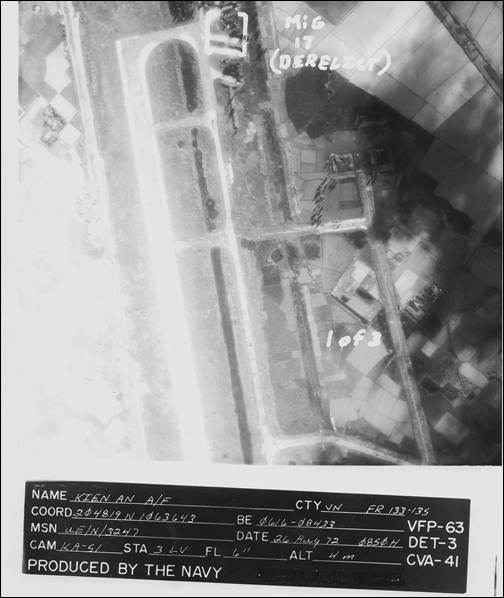
When I heard the ‘6’ (6000 foot) call, I did a one-potato, released the bombs, and cranked in about 6 Gs to get the nose coming up. Just as we reached wings level and well into the maximum Gs of the pull up, I felt a jolt and saw a flash on my port side. We were still pretty far into the Gs, so there wasn’t a lot of time to dwell on this phenomenon. And once the nose of the plane was above the horizon, it was time to get the jinking going.
Since the airfield was south of Haiphong, and we had effectively executed a button-hook maneuver to get to the target. We were now headed roughly south and toward the coast. We were over the beach a long minute after pulling off the target. At that point the jinking could be relaxed, and we could start climbing back to altitude. When it was safe, we joined-up and returned to the carrier for an uneventful recovery.
There are two sequels to this story. The first one is my MIG Kill. After trapping aboard MIDWAY, turning in the plane, and getting out of our flight suites, Shylock and I headed to the Ready Room to brag. We figured we could start filling out the paperwork for our ‘automatic’ Silver Stars.
We hadn’t just kill a MIG; we had accomplish this as an attack crew with no forward firing ordnance (VA-115 A-6s were not equipped with guns of air-to-air missiles)! Someone in the Ready Room told me that it didn’t work like that; you couldn’t be credited for a MIG Kill, if you bombed a MIG on the ground. I figured that it took far more skill to dropping a 500 pound bomb on a MIG from 5500 feet than to shoot it down with a radar guided missile from five miles off the coast.
I was still grumbling about being gypped out of a MIG Kill the next day, when our Air Intelligence Officer showed up with a photo with the exact scene I had seen in my gunsight the day before. There in the photo at the north end of the runway at Kien An; I saw my MIG parked at the end of the airfield where I had seen it. However, the MIG was labeled as ‘derelict’, and . . . . . the photo had been taken before the day of the strike. So much for the MIG Kill!
The other sequel to the story was that strange flash and bump we felt when pulling off the target. After we had debriefed, Mondo asked me if Shylock and I had felt anything unusual when we were pulling off target. I informed him that I had, and that it was like a flash went by the port side of the aircraft. Mondo said he had experienced the same thing on his starboard side. He further went on to tell me that he thought the flash was caused by another aircraft heading in the opposite direction at the same altitude as us?
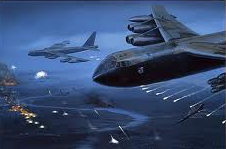 damage. Overall, the B-52s flew 795 sorties. Only about half of the total sorties-372-went to Hanoi, but all of the 15 B-52s lost were hit within a thirteen-mile radius of the capital. Ninety-two crew members were involved in the 15 losses, and 61 of the 92 were in 10 aircraft that crashed in North Vietnam. Of the 61 crew members involved in aircraft that crashed in North Vietnam, 28 died (the bodies of 7 of these have not been recovered) and 34 were captured. One of those captured died from his wounds and is included as killed in action.
damage. Overall, the B-52s flew 795 sorties. Only about half of the total sorties-372-went to Hanoi, but all of the 15 B-52s lost were hit within a thirteen-mile radius of the capital. Ninety-two crew members were involved in the 15 losses, and 61 of the 92 were in 10 aircraft that crashed in North Vietnam. Of the 61 crew members involved in aircraft that crashed in North Vietnam, 28 died (the bodies of 7 of these have not been recovered) and 34 were captured. One of those captured died from his wounds and is included as killed in action.
